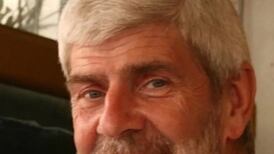The honky-tonk pianist and composer Russ Conway, who died on November 15th aged 75, enjoyed great success in the British charts during the late 1950s and early 1960s. His biggest hit was Side Saddle (1959). He emerged during a hiatus in popular music, before exportable British rock took hold, that produced a clutch of successful piano players, including Winifred Atwell and Liberace.
Russ Conway was a particular favourite. Tall, anonymously handsome and with shining white teeth, he had a particular appeal to women. He sold more than 30 million records and had 17 consecutive top-20 hits.
Throughout his life, he was prone to illnesses and accidents: he broke a hip and was paralysed for several days; he had strokes; he sliced off the top of a finger with a bread-slicer - something which, ironically, became a Russ Conway signature as television cameras zoomed into his hands on the keyboard - and he smoked up to 80 untipped cigarettes a day.
Close on 70 years of age, he jammed a finger in the door of his Rolls Royce, but he never agreed with the pundits who pensioned him off. A few months later in Bristol, he was busy entertaining a belated 50th anniversary tea-dance to celebrate VE Day, where he nonchalantly peeled off the bandage before attacking the keys.
Russ Conway was born Trevor Stanford in Bristol - the name he retained for his composing work. His mother, who died when he was 14, had been an amateur pianist and contralto in her day. Russ Conway had virtually no musical education, apart from a single boyhood lesson. His clericalworker father put him through secretarial college after he left school at 14 and then got him a job as a solicitor's clerk. But, at 16, Russ Conway entered the Merchant Navy training school.
During the second World War, he earned the distinguished service medal in the Royal Navy for "gallantry and devotion to duty" in minesweeping in the Mediterranean. After four years in the navy, he was invalided out with a stomach ulcer. After the war he seesawed between the Merchant Navy and dead-end jobs as a salesman, plumber's mate and barman.
Then a friend suggested he stand in for a holiday club pianist. He played in pubs and clubs, and was seen by the choreographer Irving Davies, who was so impressed that he asked him to play piano for stars at rehearsals. He worked for Dennis Lotis, Dorothy Squires and Gracie Fields.
But it was when Russ Conway made it to the Billy Cotton Band Show, a fixture on BBC radio and television in the 1950s and early 1960s, that the rumbustious bandleader persuaded him to loosen up his playing, and helped create the disciplined freedom of his style.
However, it was not playing but composing that indirectly led him to fame. Writing the score for a TV musical, Beauty And The Beast, he had to write a last-minute tune for one brief scene set in a ballroom. Russ Conway wrote 16 bars as an olde-world gavotte and scribbled Side Saddle beside it in the margin. Though it was to become virtually his signature tune, the music industry was, at first, blind to the piece's potential. A publisher took all his music for Beauty And The Beast - except Side Saddle, which he dismissed as "too old-fashioned". Another publisher, after its writer had honky-tonked it up, did not agree. Soon, Russ Conway was a national figure, and China Tea, Roulette and Snowcoach followed.
In 1960, when he had his first television show, Russ Conway And A Few Friends, he became an instantly recognisable face and sound.
In 1963, he had a nervous breakdown while playing at Scarborough, and then fell and fractured a hip, leaving him paralysed for three days; two years later, at only 38, he had the first of several strokes.
He had to give up playing several times, but never gave up composing. He and his compositions were heard at seaside resorts and at theatres, including the London Palladium, long after his records had vanished from the charts. He never married.
Russ Conway (Trevor Stanford): born 1925; died, November 2000









